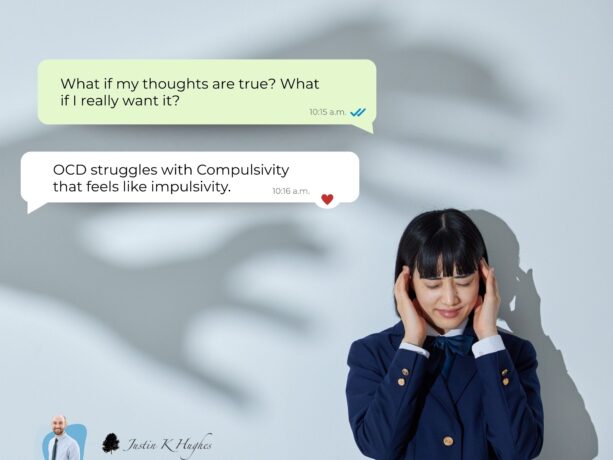
What if I want the bad thing to happen? What if I don’t really love them? What if I need to figure this out? What if me not being distressed means I’m missing something?
The Hope in the Suffering
If you ever suffer with questions like this, you are not alone. However, it is undoubtedly tough to endure if you have OCD or an Anxiety Disorder. What if, what if, what if?????
OCD often feels impulsive, and in fact, obsessive thoughts often show up as “urges”-literally a felt urge to do something that seems wrong or bad. But this is very different from the urges that show up in impulsive behaviors that a person derives pleasure from, like addictions, food, even repetitive body-focused repetitive behaviors (BFRBs), like hair-pulling, that seek to give you a positive “hit” of dopamine and other neurotransmitters.
If you have OCD, and you better know how it operates, you can catch it in its tracks and get the benefits of breaking free from its slimy little hands.
What’s the Difference?
Not all thoughts and behaviors are created equal. Sometimes we all just have passing thoughts, intrusive thoughts, unwanted thoughts, automatic thoughts, negative thoughts, positive thoughts, and so on. When working with goals that pertain to how we think, we need extra tools to support us for success.
According to Columbia Psychiatry, “Compulsive behaviors are repetitive actions driven by anxiety or distress. They often serve as a coping mechanism to alleviate stress or prevent a feared event or situation. Common examples include excessive hand-washing, checking locks multiple times, or counting rituals. These behaviors are typically linked to OCD, where the compulsion is a response to intrusive thoughts or obsessions.” However, “Impulsive behaviors are spontaneous actions performed without forethought or consideration of the consequences. These behaviors are driven by immediate desires and can manifest as spur-of-the-moment decisions, like spontaneous shopping sprees or reckless driving. Impulsivity is a common feature in several mental health disorders, including attention-deficit/hyperactivity disorder (ADHD) and borderline personality disorder (BPD).”
OCD experts commonly distinguish between ego-syntonic and ego-dystonic thoughts. It’s a helpful separation. Be careful not to get hooked on figuring out the difference in the moment—that’s likely compulsive.
Here’s an old Youtube I did years ago to help (if you’re getting this post autosent from my newsletter you might not be able to see it–click here:
https://www.youtube.com/watch?embeds_referring_euri=https%3A%2F%2Fwww.justinkhughes.com%2F&source_ve_path=MTY0OTksMjg2NjQsMTY0NTAz&v=apr0M6b8tNg&feature=youtu.be
What Do I Do?
Specialized treatment helps immensely. If you’re struggling, consider these:
- Tell a trusted other
- Find a therapist trained in working with these things (I recommend IOCDF.org or ADAA.org), or myself!
- Take an online course to learn more or strengthen your recovery (like mine!). See www.justinkhughes.com/course
- Stay apprised on my newsletter (or update your preferences): www.justinkhughes.com/getunstuck
In this together,
~Justin K. Hughes, MA, LPC








Leave a Reply